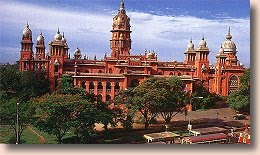Cites 2 docs
Supreme Court of India
Bhilwara Dugdh Utpadak Sahakari ... vs Vinod Kumar Sharma Dead By Lrs & ... on 1 September, 2011
Bench: Markandey Katju, Chandramauli Kr. Prasad
IN THE SUPREME COURT OF INDIACIVIL APPELLATE JURISDICTION
CIVIL APPEAL NO. 2585 OF 2006
BHILWARA DUGDH UTPADAK
SAHAKARI S. LTD. Appellant (s) VERSUS
VINOD KUMAR SHARMA DEAD BY
LRS & ORS. Respondent (s) O R D E R
Heard learned counsel for the appearing parties.
This Appeal has been filed against the impugned judgments dated 23.08.2004 and dated 21.09.2004 passed by the High Court of Judicature at Rajasthan. This Appeal reveals the unfortunate state of affairs prevailing in the field of labour relations in our country.
In order to avoid their liability under various labour statutes employers are very often resorting to subterfuge by trying to show that their employees are, in fact, the employees of a contractor. It is high time that this subterfuge must come to an end. Labour statutes were meant to protect the employees/workmen because it was realised that the employers and the employees are not on an equal bargaining position. Hence, protection of employees was required so that they may not be exploited. However, this new technique of subterfuge has been adopted by some employers in recent years in order to deny the rights of the workmen under various labour statutes by showing that the concerned workmen are not their employees but are the employees/workmen of a contractor, or that they are merely daily wage or short term or casual employees when in fact they are doing the work of regular employees. This Court cannot countenance such practices any more. Globalization/liberalization in the name of growth cannot be at the human cost of exploitation of workers. The facts of the case are given in the judgment of the High Court dated 23.08.2004 and we are not repeating the same here. It has been clearly stated therein that subterfuge was resorted to by the appellant to show that the workmen concerned were only workmen of a contractor. The Labour Court has held that the workmen were the employees of the appellant and not employees of the contractor. Cogent reasons have been given by the Labour Court to come to this finding. The Labour Court has held that, in fact, the concerned workmen were working under the orders of the officers of the appellant, and were being paid Rs 70/- per day, while the workmen/employees of the contractor were paid Rs. 56/- per day.
We are of the opinion that the High Court has rightly refused to interfere with this finding of fact recorded by the Labour court.
The Judgment of this Court in Steel Authority of India vs. National Union Waterfront Workers(2001) 7 SCC 1 has no application in the present case. In that decision the question was whether in view of Section 10 of the Contract Labour (Regulation and Abolition) Act, 1970 the employees of contractors stood automatically absorbed in the service of the principal employer. Overruling the decision in Air India Statutory Corporation vs. United Labour Union, (1997) 9 SCC 377 this Court held that they did not.
In the present case that is not the question at all. Here the finding of fact of the Labour Court is that the respondents were not the contractor's employees but were the employees of the appellant. The SAIL judgment (Supra) applies where the employees were initially employees of the contractor and later claim to be absorbed in the service of the principal employer. That judgment was considerating the effect of the notification under Section 10 of the Act. That is not the case here. Hence, that decision is clearly distinguishable.
Mr. Puneet Jain, learned counsel for the appellant submitted that the High Court has wrongly held that the appellant resorted to a subterfuge, when there was no such finding by the Labour Court. The Labour Court has found that the plea of the employer that the respondents were employees of a contractor was not correct, and in fact they were the employees of the appellant. In our opinion, therefore, it is implicit in this finding that there was subterfuge by the appellant to avoid its liabilities under various labour statutes. For the reasons given above, there is no infirmity in the impugned judgment of the High Court. The Appeal is dismissed accordingly. No costs. ...................................................J
[MARKANDEY KATJU]
...................................................J
[CHANDRAMAULI KR. PRASAD]
NEW DELHI;
SEPTEMBER 01, 2011

